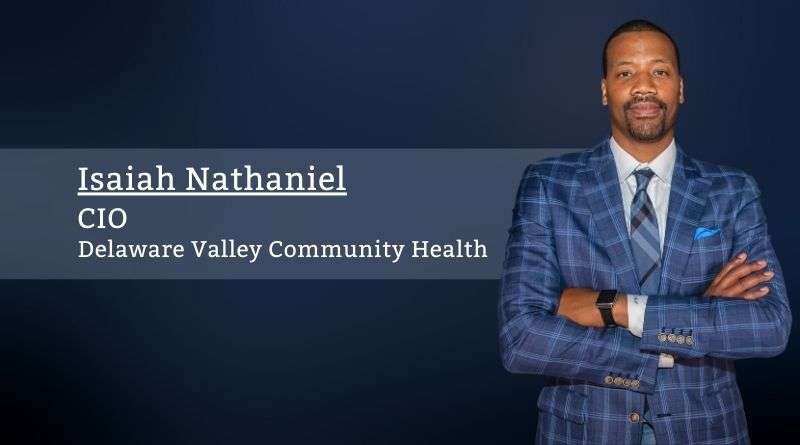Drop the wires, but don’t leave the patient behind
By Isaiah Nathaniel, CIO, Delaware Valley Community Health
March 11, 2020 is when the World Health Organization (WHO) classified the coronavirus outbreak as a pandemic. Since that time, we have witnessed and watched as one of the most resilient sectors of the world kick itself into high gear performing well beyond the normal asks and put oneself-last and others first. In such, Digital Health has been adopted at a rate shocking to most. What used to be a lackluster approach to innovation in healthcare, barriers have been removed, allowing for the thoughtful implementation of digital health tools that completed the necessary business continuity and resiliency needed to fight a pandemic and the complexity of healthcare.
Now, I am not slight to the fact that not all were as bad as the previous statements make it seem, although the comments from the collective healthcare industry are appropriate and the perspective valid. At the base level, not all providers of the healthcare community had a telehealth program for a myriad of reasons. Not all funding reimbursed Telehealth visits and subsequently, in many instances, the Information Systems infrastructures were not ready for such, to name a few of the challenges.
The USFDA defines Digital Health as the broad scope to include categories such as mobile health (mHealth), HIT, wearable devices, telehealth and telemedicine, and personalized medicine.
It further states that Digital health tools have the vast potential to improve our ability to diagnose and treat disease accurately and enhance the delivery of health care for the individual.
In this Digital Health shift, it’s exciting to fathom this in the reality of Information Systems (IS) because the patient choice has pushed healthcare to reimagine delivery and close the widening tech gap, particularly in the primary care sector.
In this Digital Health shift, it’s exciting to fathom this in the reality of Information Systems (IS) because the patient choice has pushed healthcare to reimagine delivery and close the widening tech gap, particularly in the primary care sector.
I get it! I understand that primary care is the “contact” aspect of medicine that has been the bedrock first point of entry for the healthcare wheel by all patients. Even by definition by the American Academy of Family Physicians (AAFP) define Primary Care as care provided by physicians specifically trained for and skilled in comprehensive first contact and continuing care for persons with any undiagnosed sign, symptom, or health concern.
It continues with the diagnosis and treatment of acute and chronic illnesses in various health care settings (e.g., office, inpatient, long-term care, home care, etc.)
Primary care is performed and managed by a personal physician, often collaborating with other health professionals and utilizing consultation or referral as appropriate. Primary care provides patient advocacy in the health care system to accomplish cost-effective care by coordinating health care services.
Primary Care physicians are trained in the idea of in-office patient care settings for obvious reasons but add a pandemic and the notion that in-office isn’t ideal for care relative to curbing virus spread, we must start to re-think, how we deliver such care. I am not articulating that once we are back to normalcy, we continue to disregard in-office care, but what I am challenging is that patient choice matters even after the pandemic, and we must provide IS solutions that promote a balance of patient choice and quality care. A delicate balance is achievable with a strategic approach starting with Telehealth and Remote Patient Monitoring.
These two digital health modalities are sufficient beginning stages towards gap closing. In patient’s reality, time is one of the most valuable things that cannot be wasted. Patients are more than a medical record number, rather they are humans in the midst of everyday life and the healthcare industry should not present itself as a barrier to such. A parent(s) of children trying to live a healthy life individually and collectively can have as many as 20 healthcare appointments in a year for a family of four (multiple factors applied i.e., age, gender, and health disparities.) For elderly patient(s), this number increases accordingly. This is time off from work, taken away from vacation/sick days, not recoverable until the next allotment. Humans value such time away as it is needed for some semblance of work-life balance. To impede on that should not be taken lightly. This is where we have watched patient choice become one of the deciding factors as patients are searching for primary care physicians hospitals and referring specialists.
Enter in Telehealth and Remote Patient Monitoring. Having the ability to have a Virtual Visit that incorporates the traditional visit adding the device readings is the best of both worlds. The ability to take BMI’s and such on a device and be able to calculate readings and simultaneously drop this data into the medical chart while the provider is on the call is, in my opinion, a holy grail of hybrid compromise. Does this negate the visits that truly need to be in the office; no! Does it provide patients with the ability to manage their time and still walk the journey of whole person health; yes! Does it help minimize stress on the healthcare system from reducing no show rates and provider double booking; yes! Does this complete the Quadruple AIM; yes! As we begin to round the corner on the coronavirus, the wins we have achieved as an industry need to be celebrated, but we also must look into the new normal and say to ourselves, what’s the goal of our system? To provide quality care at an affordable cost that reduces the burden on both the patient and the provider. Opening our four walls to Digital Health is one way Information Systems departments can continue to play a critical role in the strategic decisions for business resiliency. It’s how we as healthcare drop the mask and bridge the human gap into our system that we are all a part of while we are at work ourselves.



